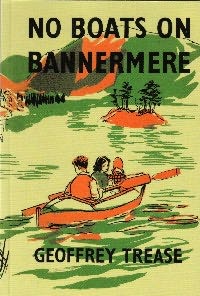No Boats on Bannermere facts for kids

First edition cover
|
|
| Author | Geoffrey Trease |
|---|---|
| Illustrator | Richard Kennedy |
| Language | English |
| Genre | children's fiction |
| Publisher | Heinemann |
|
Publication date
|
1949 |
| Followed by | Under Black Banner |
No Boats on Bannermere is an exciting children's novel written by Geoffrey Trease. It was published in 1949. This book is the first of five stories in his famous Bannerdale series. These books are school stories that take place in the beautiful Lake District area of Cumberland, England.
Contents
What Happens in the Story?
William and Susan Melbury are a brother and sister. They live with their mother in London. After some family changes, their mother inherits a lovely cottage. It is called Beckfoot Cottage. The cottage is in a beautiful place called Bannermere.
There is a special rule about the cottage. Their cousin Fay, who owned it before, wanted someone to live there. So, the family must live in the cottage for five years. This means they have to move from London to Bannermere. Bannermere is in Upper Bannerdale, a stunning part of the Lake District.
William and Susan start new schools in a town called Winthwaite. It is about five miles away. William attends a boys' grammar school. Susan goes to a county secondary school. William quickly becomes friends with Tim Darren. Susan makes a new friend named Penelope, or Penny.
William soon discovers that his cousin Fay also owned a rowboat. The friends use it to explore Brant Holm. This is an island in the lake. But then, Sir Alfred Askew arrives. He recently bought Bannermere Hall. He stops the local farmer, Mr. Tyler, from letting them use the boathouse. Sir Alfred acts like a very important person.
The children start to suspect Sir Alfred is hiding something. They explore his woods. There, they find an old skeleton buried near the lake. It turns out there are actually five skeletons! They might be from the 9th century. This was a time when Vikings raided the area. Sir Alfred had not told the police about his discovery.
An official investigation is held. Later, William sees an aerial photo of the lake. It shows a hidden burial spot on the island. The friends investigate the island. They uncover another skeleton. But Sir Alfred and his friend Matson, an antique dealer, interrupt them. They also find some old silver dishes and jugs. These are probably a monastery treasure. An old book from St Coloumbs Abbey in Yorkshire mentioned this treasure.
At the investigation, the items are declared "treasure trove." This means they belong to the Crown. The skeleton was Christian and buried facing east. Tim's photo helped prove this. As the finders, the four friends each receive a reward of three hundred pounds. Sir Alfred had tried to claim the items. He said they were not treasure trove. If they were not, they would belong to him as the landowner. Matson had planned to sell them for a lot of money in America.
The Fictional World of Bannerdale
In the Bannerdale book series, Bannermere is a small village. It is located in Upper Bannerdale. The village is right on the edge of a lake also called Bannermere. Across the lake is a tall mountain, Black Banner. It is 2783 feet high.
Geoffrey Trease, the author, explained how he created Bannerdale. In 1940, he taught at a school in Gosforth. He was waiting to join the army. He realized he was in the area that would inspire his stories.
Trease said that Bannermere is not on any real map. There is a real Banner Dale, but it's different. His Bannerdale, with its lake and island, is a fantasy place. Authors often create such places. It's a mix of real places. It's mostly like Wasdale and Eskdale. The "Gates of Bannerdale" are like the Jaws of Borrowdale. "Black Banner" is like the real mountain, Black Sails. His town of "Winthwaite" is based on Cockermouth. He moved it south for the books.
Today, Bannerdale exists in the minds of many readers. Children and adults from all over the world have read these stories. This includes readers from Japan, Sweden, and Brazil.
How the Story Came to Be
Geoffrey Trease is famous for his historical novels for children. But the Bannerdale books are different. They are school stories set in his own time. They focus on day schools, not boarding schools. The story is about two boys and two girls.
William and Susan's mother is described as modern. The book mentions "family difficulties" that led to their move. The headmaster at the Grammar school, Mr. Kingsland, is old-fashioned but cares about his students. William is in the middle school. He notices that Penny is attractive. William dreams of becoming an author. He buys a typewriter with his reward money.
Trease once gave a talk about children's books in Millom. Two schoolgirls approached him afterwards. They asked if he ever wrote school stories. He said no, thinking of old-fashioned stories. But they told him they wanted "true-to-life" stories. They wanted stories about real boys and girls. They wanted stories about day schools, which most kids attended.
This five-minute conversation inspired Trease. A few years later, No Boats on Bannermere was published. It led to four more books in the series. He wrote over three hundred thousand words over nine years. Trease was very glad he had visited Millom.
The Bannerdale Novels
There are five books in the Bannerdale series:
- No Boats on Bannermere (Heinemann) (1949)
- Under Black Banner (Heinemann) (1951)
- Black Banner Players (Heinemann) (1952)
- Black Banner Abroad (Heinemann) (1954)
- The Gates of Bannerdale (Heinemann) (1956)

